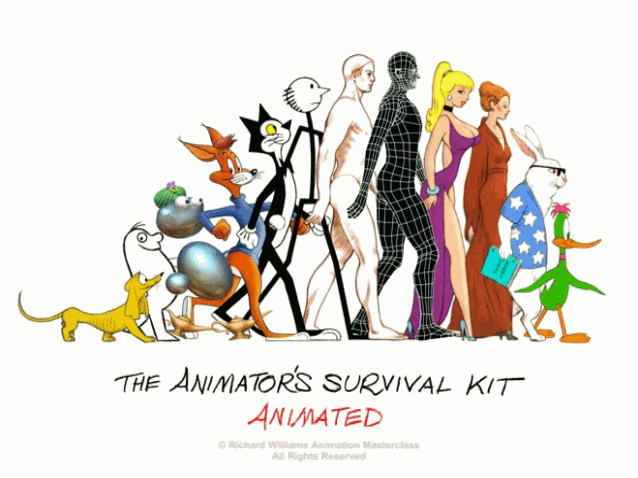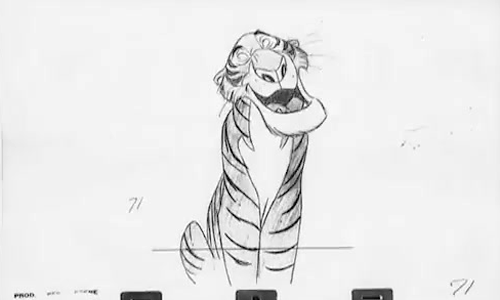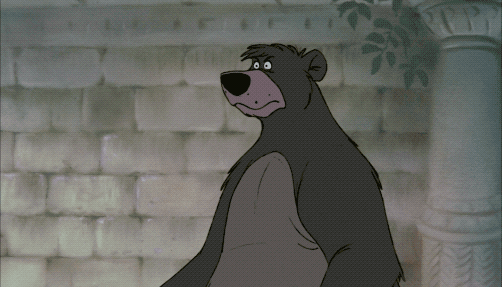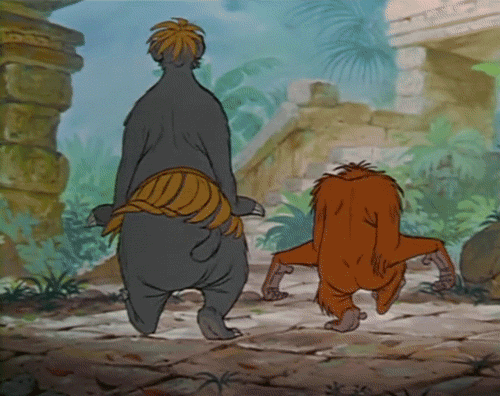Walk Cycle (Gorilla)
Learning to make a character walk convincingly in animation is regarded as the most difficult and also the most important skill to master. I have been excited to take this on ever since I found Richard Williams' instructional series and book- The Animator's Survival Kit, which covers the basics of walks and then how to add personality to that framework. I was glad to find that we are using Williams' diagrams in class as I find them approachable and clear. For a subject so complicated, with so many drawings overlapping, it's a relief to be able to take it step by step.
I still feel intimidated by animation, but I'm starting to understand enough to be able to play with it.

First, I need a character. Here are my sketchbook pages exploring a few possibilities. We were given a select list of characters and emotions to assign them, in any combination. I sketched out: an angry chef, a cheerful professor, and a sad florist.


I liked all of these ideas and enjoyed thinking about translating the emotion into body language and speed/type of walk. When I have time in the break for summer, I think I'll keep practising with different types of character. It has always been the performance, specific to character, that attracted me to animation. There's a big, hammy part of me that loves pulling faces in the mirror and exploring acting in general. Studying animation will hopefully give me reason to explore that dormant side of myself again in figuring out how to convey a multitude of emotions.
Ultimately, my next idea would be my final choice: a gorilla in love.
The sketchbook has been a great space to explore different gestures, particularly as 'in love' is a little more complex an idea than simply 'sad' or 'angry'.



I drew from imagination and also researched gorilla physicality. It's always useful to learn from reality and then exaggerate and depart from it once I have a clearer understanding of the basic forms.
I am also attending life drawing sessions when I can find time in-between classes. Though I'm currently drawing an imaginary gorilla, the study of any real life body (still or moving) does help my overall skill in animation. Naturally, my gorilla is slightly anthropomorphised to show a heightened sense of expression.

Character turnaround
Next I needed to create a more consistent character sheet, showing my gorilla from several angles:
the side, the three-quarter view, and the front.
In designing my final character, I wanted him to have a solid sense of structure and consistent anatomy. I want to challenge myself while I have the space to experiment on this course.

For these polished drawings, I looked at what worked in my rough sketches. I included a strong lean back, holding the head up to the sky. I think this shows a dreamy quality, particularly with his eyes closed and his mind blissfully elsewhere. The chest swells with newfound love, pushing out and upwards. There's a playful swing in the arms, beyond any natural swing, where he is playing with the way his limbs sway without a care in the world.
In the facial expression, there is a gooey, silly glee in being lovestruck. I put a slight puckering of the lips in the walking poses. These additional touches are important but I should be conscious of making the walk itself the main thing communicating the emotion. For instance, I shouldn't require the cartoon love hearts floating in the air for a viewer to understand what the gorilla is feeling.
I need to further consider what the feet are doing. Here they are either skipping in the walk or slightly bashful in the standing pose. For the final animation I will need to decide on something more consistent.

The gold standard in animation to me is Disney's The Jungle Book (1967). I still marvel at the artistry on display, conveying a variety of specific animal movements according to weight, balance and distinct personality. I love the sketchy linework of Disney studios' animation in the 1960s, and I've brought some of that flavour to my gorilla, with a suggestion of hairiness too.
I have no expectation to ever reach the level of the great Disney animators. But I don't see the harm in being ambitious; I'm sure to discover just how much I have yet to learn by falling short.


Baloo gets caught up in the beat.
Shere Khan pencil test by the legendary Milt Kahl.
Adobe Animate practice
For this project, we are using Adobe Animate for the first time. Again, it's a challenge to adapt to new software but we helpfully started on something straightforward- the bouncing ball. This familiarised us with the process of creating new frames and moving/distorting objects on the blank cell canvas. It is different to TVPaint in the means of adding and stretching frames. More importantly the image is scalable, being vector-based, meaning the clean shapes can be vastly scaled up without losing pixel clarity like other software.

A ball test using line only.

A ball test using just flat shape, stretched and moved.
First walk...
Referring to Richard Williams' diagrams, we got practising on a standard walk. Before adding much more personality, I need to start by gaining some understanding of the basics.
The essentials, as shown in this diagram, are in determining the following:
-
'Contact' positions - where the front heel first contacts the ground.
-
'Passing position' - the middle point of switching the legs.
-
'Down' pose, where the body shifts down, as the front leg takes the weight.
-
'Up' pose, as the body lifts slightly to prepare for throwing the leg forward.
Any in-between poses can be added later.

The animated sketch below was my first attempt at a standard walk, using my gorilla for practice. I left the overall expression neutral but started to think about weight shifting. It's usually in the moment of the front knee catching the body that we feel the weight of the figure.
I ignored the arm animation here as it's not essential yet to learning the walk pattern, and can be added separately. For later stages of my 'gorilla in love' animation, I will think more deliberately about delaying the swing of the arms and playing with a looping motion.
When animating a walk I have the option of drawing my character in a fixed spot (as if on a treadmill) or to track the movement across the space. I went with the latter option here, to see how the walk would look if my character went from one side of the frame to the other. I concentrated on the fixed position of the foot on the ground as a consistent pivot point.

More sketchbooking...
As I prepare to get started on the fully realised animation for the walk, I go back to my sketchbook to get into character. The more I familiarise myself with the expressions at this stage, hopefully that experience through trial and error will pay off in the final version.



I always benefit from more sketching. I can be set in a particular way of thinking and then one investigative sketch will shake things up and bring a new kind of life to my work. Even when I'm simply refining my poses, it's useful to stretch and exaggerate on throwaway pages so that I can find the right balance before (and during) the animation stage.


Animating (Straight Ahead)

My starting point was to just get to animating, without much strategy. Essentially all of my experience with animation up to the point of doing this course follows this spontaneous approach. With previous blog research, I have come to understand this is known as 'straight ahead' animation; just going ahead and getting into a fun flow.
The trouble is the inevitable inconsistency. I was mixing ideas from my sketchbook: am I doing a tiptoe walk or leading with the heel? I was trying to juggle too many elements at once: the legs, the arms, the tilt of the shoulders... It takes a hell of a lot of concentration to work this way, without a planned structure via key frames.
I got lost.
Going forward, I am starting fresh on an alternate take. Nevertheless, I have saved this as an animated sketch as there are some qualities of weight and swing that feel right.
Live action reference
I feel like I need all the help I can get to get a consistent walk cycle that is true to character, so I decided to go out and get a live action video reference of myself. My partner, Zoe, helped to film this, and we tried several takes before arriving on this version. I intend to exaggerate when transferring this to the gorilla model, but I wanted to have some core elements in place to refer to. If I can avoid it, I don't want to be guessing at the correct timing.
It seems the unhurried skip does communicate something more of being in love than just a walk without that care-free bounce. That sense of skipping was evident in my earlier turnaround sketches and got left behind along the way, though I'm happy to reintroduce it. It was very useful to have a second opinion watching the movements so we could discuss what was working through various takes.

Key frames
Using the live action reference by going frame by frame, I found some key poses: the contact, the down, the passing position, the up and the next contact. This is following the basic components mentioned earlier. Although this is a more complex 'walk', the framework of these poses was very useful just to get my bearings on the looping pattern.
Here I was looking to have a skip that wasn't too slow as to keep some bounce and momentum, yet leisurely enough to feel care-free. I spaced out the frames to what I felt was the right timing on playback. It roughly timed out to four-five frames per key pose, leaving me with plenty to figure out on the in-betweens. I need to add more character and emphasis to the arm swing, exploring any drag through offset timing.
I have found myself scrapping different attempts at refining this animation. At least I am learning a lot as I go, even when I simply learn what isn't working.
Trial and error...
Trying to figure out this walk cycle has been a really steep learning curve. As I had very specific body language and movement in mind, I went through several attempts at getting that right, using different practice layers. I could use the translucency of a previous attempt's layer to overlay a better version, further emphasising the bounce or swing of the skipping action.
Also I tested the offset timing of the arms and head, with extreme and subtle delays. The most effective way of showing the offset timing was in the shoulders, hopping up marginally after the feet and then dragging the arms. The guidelines on this screenshot denote the arc of the arm swing and the tilt of the chest piece.

Shown here is an additional step of deconstructing the basic shapes of the gorilla's 'anatomy'. I felt like I needed a very clear structure for reference on the movements of each limb. With only rough shapes to practice with, I could feel free to mess with the timing and exaggeration without getting too concerned with quality of drawing. It helped to break everything down to the bouncing ball principles, thinking about how inanimate objects behave according to basic physics. I will definitely use this technique again as a skeleton underneath future animations of the figure.
Essentially I am learning the value of using every bit of assistance I can think of to inform my work. My first impulse is usually to go in at the deep end and try to do the final drawings. I realise now that there's no shortcut to all these layers of practice, if I truly want to get a solid result.
Finalising the loop
Using all of that previous practice, I ended up with this final version. All things considered, I'm happy with how it came together. At times I was incredibly frustrated with a feeling of being at a dead end, clueless about how to make progress. What I was searching for was a genuine sense of life and character. Though there is still a roughness to this, I'm glad to have found that feeling of a hefty gorilla and a playful swing that is satisfying to watch.
It's exciting to discover what's possible in a relatively short space of time. My experience with hand-drawn animation like this is very minimal but I can already taste the potential of where I could go with it. I have been passionate about animation for my whole life but always felt it was one step too far to believe that it was within my ability to create something sophisticated.
Previously I mentioned how The Jungle Book is a primary inspiration for venturing into animation. The believable shifting weight and convincing movement of the characters are what I hoped to replicate one day. I'm still at the beginning of a long journey but at least I know that there are means of figuring this out, even if it takes a lot of mistakes and sweat to get there.




